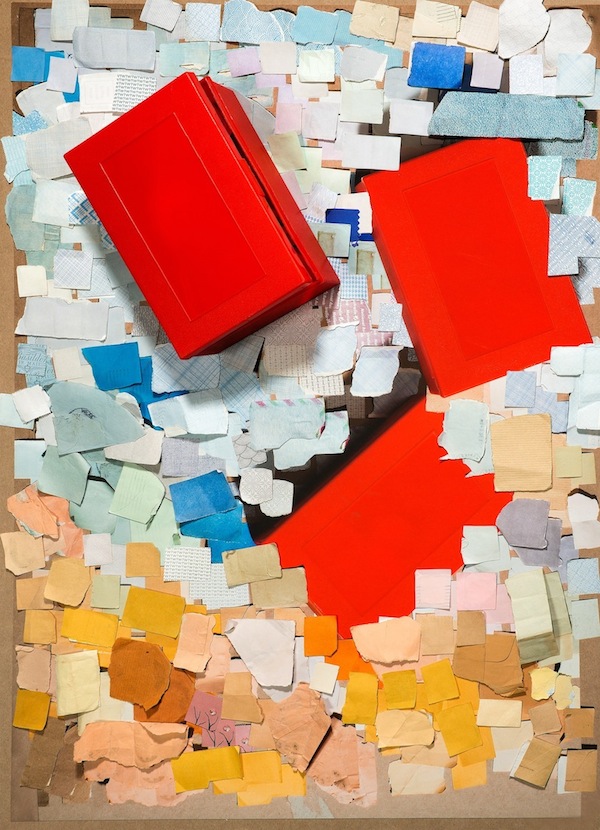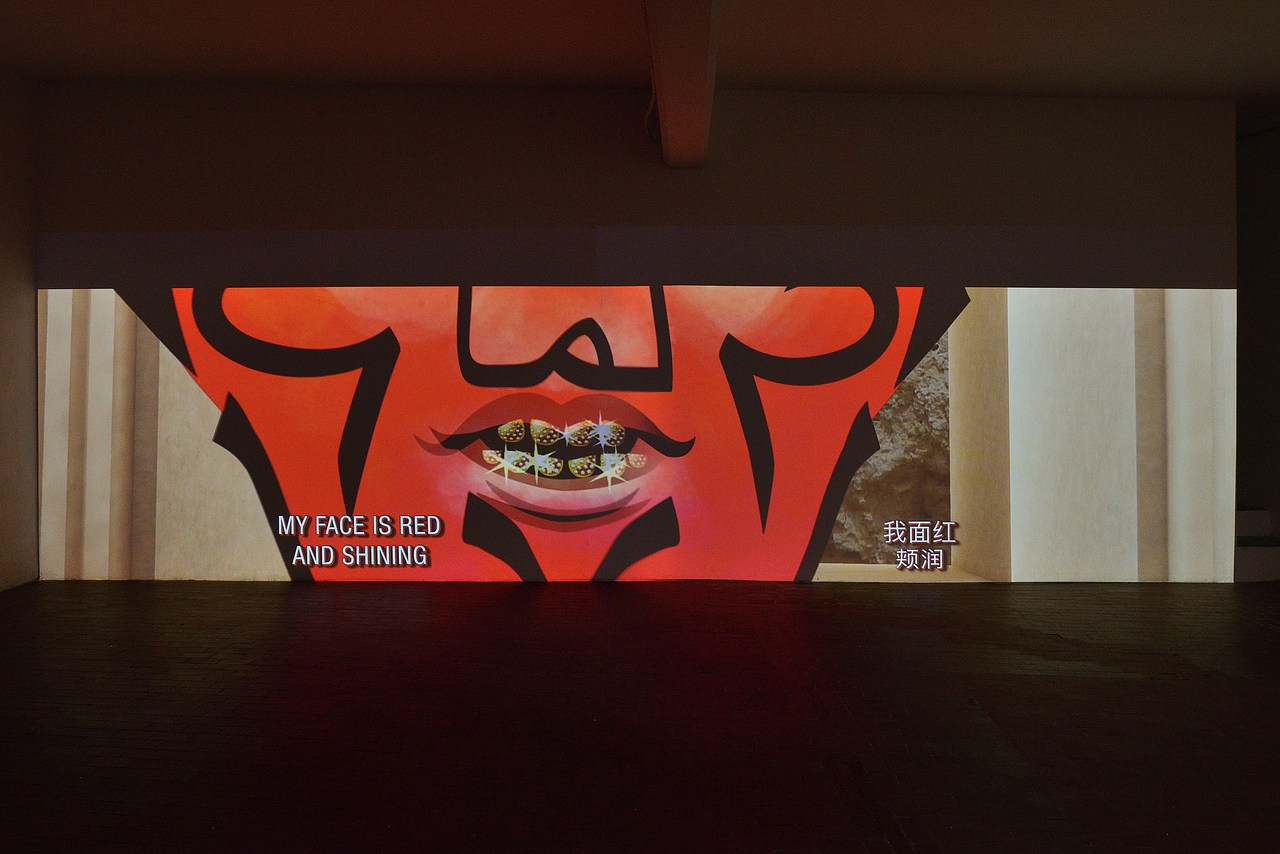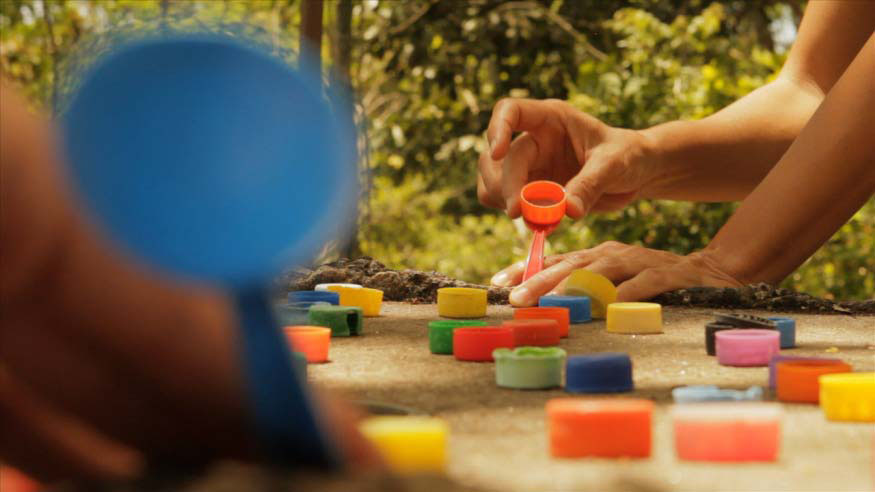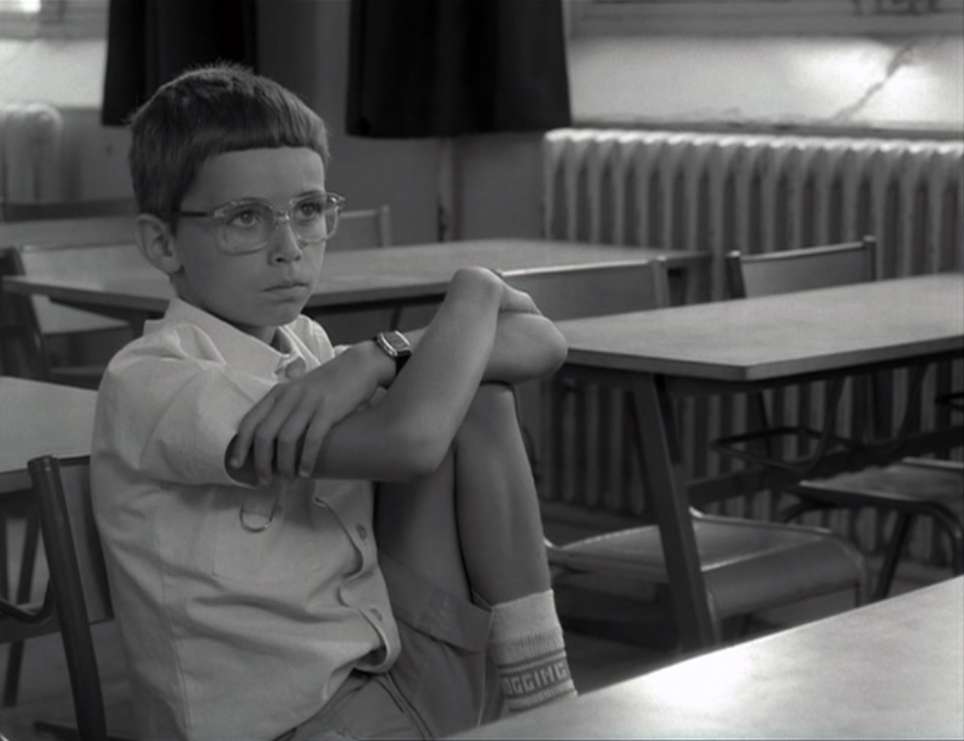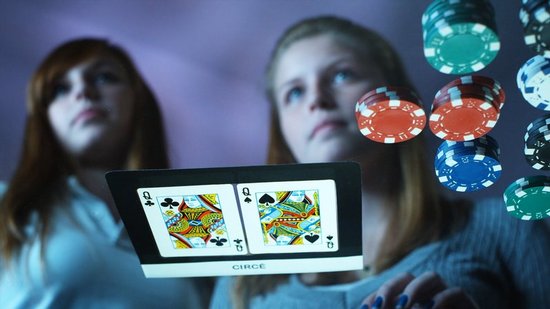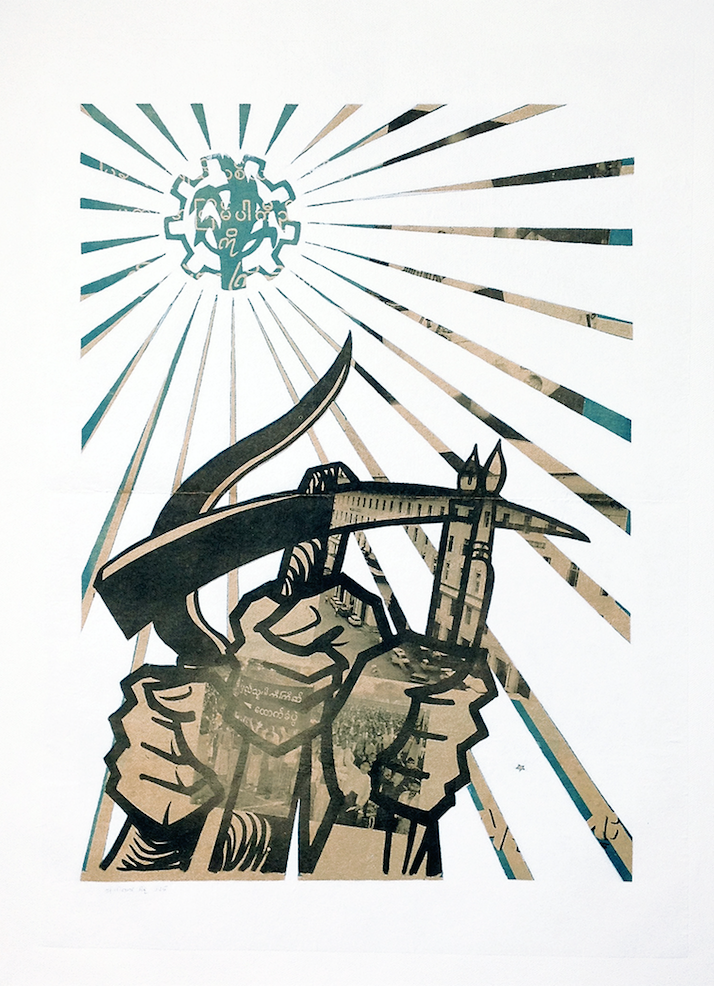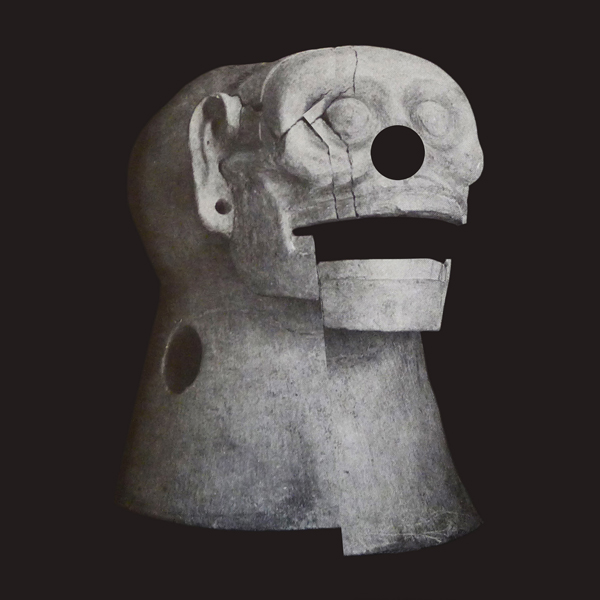
© » KADIST
John Lucas and Claudia Rankine
Drawing & Print (Drawing & Print)
Historically, blondeness has been a signifier for desirability and beauty, speaking to “purity” — the purity of whiteness — like no other bodily attribute except, perhaps, blue eyes. In the twenty-first century, blondeness is the look desired by American presidents, pop stars, rappers, television announcers, Hollywood celebrities, the boy next door, and some Asian Americans, African Americans, white Americans, Arab Americans, and LatinX Americans. The desirability of blonde hair has no genre boundaries, no pronoun limitation, and no class limit.

© » KADIST
John Wood and Paul Harrison
One of John Wood and Paul Harrison’s earliest works, Device features Harrison performing a series of actions, assisted by the titular ‘devices’, that use physics to force his body into unusual and uncomfortable positions. Maintaining his signature deadpan expression throughout the video, in one scene Harrison is thrusted into the air by a slowly inflating balloon until only his feet are visible in the frame, while in another he levitates in diving position with the help of a pulley system. Wood uses his body and specially-designed props created by the artist duo to explore the space of the screen in hilarious, and sometimes clumsy or violent, ways.

© » KADIST
John Wood and Paul Harrison
3-Legged is an early video work by John Wood and Paul Harrison in which they appear with their legs tied together (as one would do in a three-legged race). Wood and Harrison stand together in a narrow alcove built into their studio, dressed similarly in grey long sleeve shirts and jeans. Facing a tennis ball machine that is almost completely out of view, with only the barrel of the machine protruding from the bottom of the frame, they hobble back and forth across the alcove attempting to avoid the tennis balls launching toward them, with varying degrees of success.

© » KADIST
Renata Lucas
Lucas’s quadroquadro (círculo) employs familiar materials for the artist: wood, paper, and glass. A simple composition—a black circle inscribed on white paper, encased in a rectangular frame—is interrupted in Lucas’s work, the continuous geometry of the nested forms segmented into four broken shards. Pieced back together, these fragments comprise a whole, but it is a unity shattered, unsteadied.
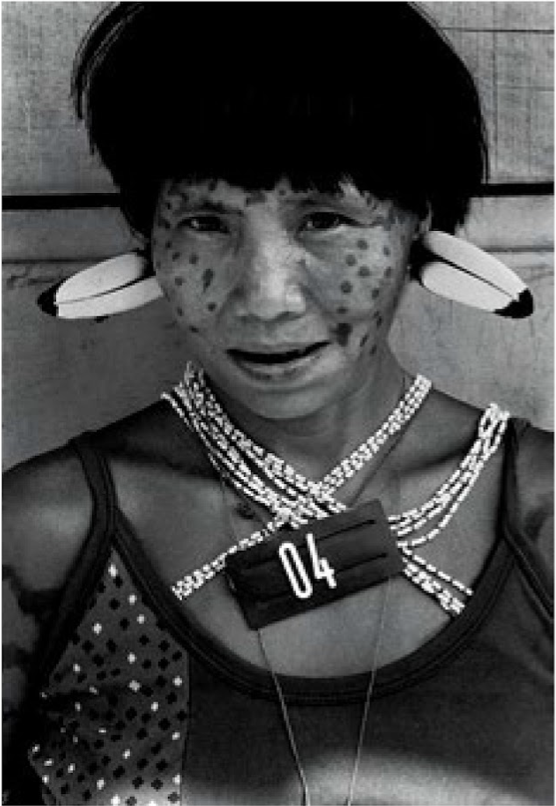
© » KADIST
Claudia Andujar
In 1980, with the construction of highways in Indigenous territories, an epidemic was brought to the Yanomami region. As the Yanomami do not have first names, it was necessary to give them numbers to indicate that they had already been vaccinated and identify each one for their medical records. From this series of events, Claudia Andujar’s Marcados series was born: what was supposed to be a mere photographic record, for organizational purposes, ended up raising a big question about the “labels” given to people in the construction of societies.

© » KADIST
Claudia Joskowicz
Los rastreadores is a two-channel video by Claudia Joskowicz narrating the story of a fictitious drug lord, Ernesto Suarez, whose character is based on the well-known Bolivian drug dealer, Roberto Suárez. In the video, Suarez returns home from prison and survives a massacre that takes place at his home in Bolivia. Told in four chapters, the story is inspired by John Ford’s American Western classic film The Searchers (1956), this work similarly focuses on the politicized atmosphere of Bolivian history, searching for cues of race and alienation.

© » KADIST
Claudia Joskowicz
The primary interest in the trilogy is Joskowicz’s use of cinematic space, with long tracking shots that portray resistance to habitual viewing experiences of film and television. Video plays a role in the relation between the use of her locations and the stories of actual figures depicted as central in the frame. The meaning behind these historical icons such as Che and Cassidy, speak to their stories as itinerant figures whom traveled in a preglobalized era through borders and cultures in order to escape the law or overthrow it.

© » KADIST
Lucas Blalock
Compositions such as Tree on Keystone (2011) become hyperreal versions of their real-world equivalents. Blalock resists the immediacy that we have come to expect from photography—that each photograph should communicate its message without delay.

© » KADIST
Lucas Blalock
Drawing & Print (Drawing & Print)
Blalock resists the immediacy that we have come to expect from photography—that each photograph should communicate its message without delay. Within the dark obscurity of three, three, three (2013), he frustrates and complicates this conditioned response to the photographic medium, questioning the photograph’s purpose.
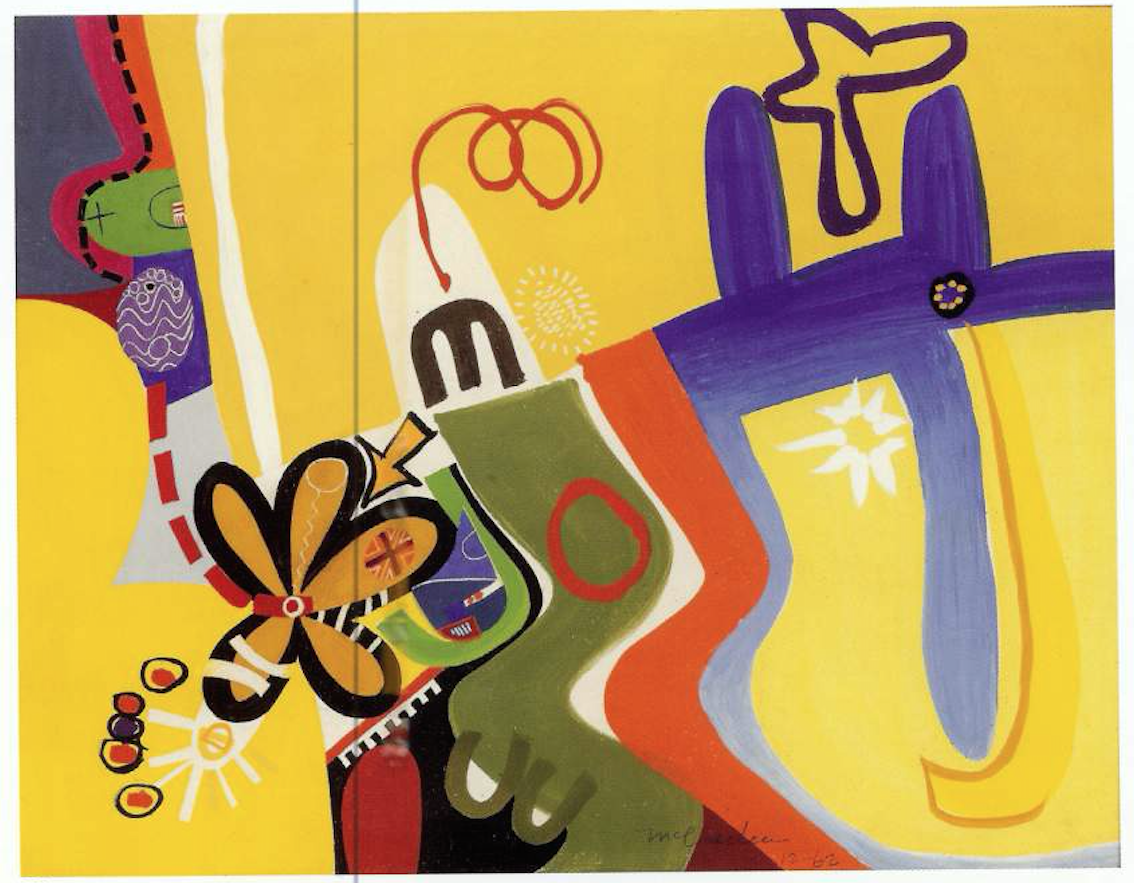
© » KADIST
John McCracken
Though not strictly representational, some objects in Untitled (1962) are recognizable: a flower, an egg, a foot. The arrows and directional lines suggest movement, but the forms they point to intertwine, prohibiting a straightforward reading. The shapes are as illustrative as a Rorschach inkblot; in their confounding, simple indeterminacy, they depict nothing and everything at once.

© » KADIST
John Menick
The theme of the end of the world, of the last man on earth, recurs in our literary and cinematographic culture and in our imaginary: “we had this dream before, the dream that we’re alone.” In The Secret Life of Things , the narrator presents himself as an enthusiast and expert on films announcing the end of the world and those staging someone waking up to discover that they are the only survivor on earth. Like in some works by Mario Garcia Torres (like The Transparencies of the Non-Act , a slide projection about the artist Oscar Neuestern, Kadist Collection), the artist lends his discourse to a stranger. Mastering the montage, he intersperses a monologue and images.

© » KADIST
John Isaacs
A child and dreamer my whole life long (broken tree) (2004) is a sculpture made of filler, wire, copper, oil paint, and wood depicting a tree just at it’s moment of breaking into half – one part alive with foliage and blooming branches and the other the crisp of the break exposed, with the trunk adhered solidly to a plinth. The sculpture appears to speak quite bluntly about Isaac’s own sense of bleak pessimism when exposing a severed tree, the universe’s sacred sign of life and birth. Through the perfect rendering of this encapsulated moment, Isaacs demonstrates the strength of the sculptural artifact and his interest in failure and fragility.

© » KADIST
John Baldessari
In One Must , an image of a pair of scissors, accompanied by the words of work’s title, poses an ominous question about the relationship between the image and the text. The otherwise banal scissors become suggestively violent in relation to the text, which was originally the title of a print in Francisco de Goya’s Disasters of War series. However, Baldessari is less interested in the logical relationships between text and image than he is with the conceptual leaps that the viewer makes with the limited information provided.

© » KADIST
John Gutmann
Gutmann’s photographs Untitled Nob Hill and From the North Tower of the Golden Gate Bridge are some of the oldest pieces in the Kadist Collection and serve as historical anchors for many of the more recent works. Distinctly modernist in style, the photos depict two of San Francisco’s most recognizable sites—the affluent neighborhood of Nob Hill and the iconic Golden Gate Bridge—through extremely estranged angles and balanced compositions. Moreover, these two images are representative of Gutmann’s work inasmuch as they epitomize two of the photographer’s visual obsessions: the automobile and the city of San Francisco.
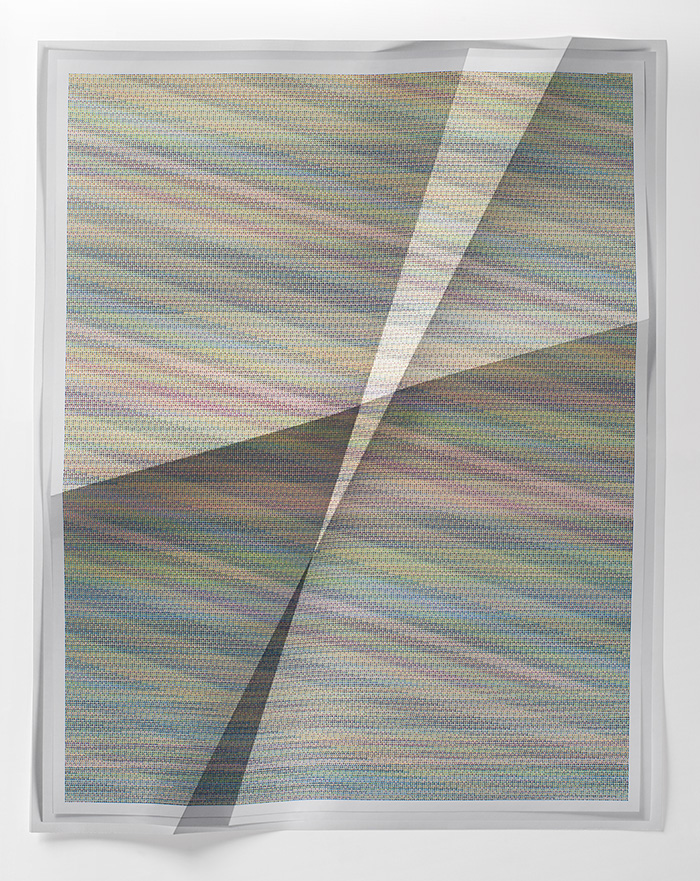
© » KADIST
John Houck
Untitled #242 is part of Houck’s Aggregates Series, which uses digital tools to manipulate chosen sets and pairs of colors, creating colorful index sheets, bathed in colors and lines. Houck transforms these simple outputs physically, folding, lighting, photographing, and re-printing them, only to fold, photograph, and re-print again. An MFA graduate from UCLA, John Houck works primarily in the medium of photography and specializes in still-life vignettes.

© » KADIST
John Houck
Houck’s Peg and John was made as part of a series of photographic works that capture objects from the artist’s childhood. In this image, drafting materials (pencils, compasses, and protractors) are laid out next to shotgun shell casings. Presenting these objects in juxtaposition but without commentary, Houck offers a partial but interesting glimpse into his own biography.

© » KADIST
Claudia Andujar
In 1980, with the construction of highways in Indigenous territories, an epidemic was brought to the Yanomami region. As the Yanomami do not have first names, it was necessary to give them numbers to indicate that they had already been vaccinated and identify each one for their medical records. From this series of events, Claudia Andujar’s Marcados series was born: what was supposed to be a mere photographic record, for organizational purposes, ended up raising a big question about the “labels” given to people in the construction of societies.

© » KADIST
Claudia Joskowicz
The primary interest in the trilogy is Joskowicz’s use of cinematic space, with long tracking shots that portray resistance to habitual viewing experiences of film and television. Video plays a role in the relation between the use of her locations and the stories of actual figures depicted as central in the frame. The meaning behind these historical icons such as Che and Cassidy, speak to their stories as itinerant figures whom traveled in a preglobalized era through borders and cultures in order to escape the law or overthrow it.

© » KADIST
Claudia Joskowicz
The primary interest in the trilogy is Joskowicz’s use of cinematic space, with long tracking shots that portray resistance to habitual viewing experiences of film and television. Video plays a role in the relation between the use of her locations and the stories of actual figures depicted as central in the frame. The meaning behind these historical icons such as Che and Cassidy, speak to their stories as itinerant figures whom traveled in a preglobalized era through borders and cultures in order to escape the law or overthrow it.

© » KADIST
Claudia Andujar
In 1980, with the construction of highways in Indigenous territories, an epidemic was brought to the Yanomami region. As the Yanomami do not have first names, it was necessary to give them numbers to indicate that they had already been vaccinated and identify each one for their medical records. From this series of events, Claudia Andujar’s Marcados series was born: what was supposed to be a mere photographic record, for organizational purposes, ended up raising a big question about the “labels” given to people in the construction of societies.

© » KADIST
Claudia Gutiérrez
The title for this body of work, Poco se gana hilando, pero menos mirando , is based on a Spanish saying that underestimates feminized crafts or tasks, implying that it is better for a woman to be doing ‘something’, no matter how useless it is, instead of just doing nothing. This series of works by Claudia Gutiérrez Marfull features embroideries that represent the peripheral and marginalized landscapes of Puente Alto commune in Santiago, the city’s biggest district and its most southern outskirts. In 2015, when this work was produced, there was not a single health service provider, police station, pharmacy, daycare or school in the whole area of Puente Alto.

© » KADIST
Claudia Joskowicz
Some Dead Don’t Make a Sound (Hay muertos que no hacen ruido) is a single-channel video by Claudia Joskowicz that features the Mexican legend of the Weeping Woman (La Llorona) as its main protagonist. The video begins with the image of a ghost-like female figure, representing La Llorona, slowly walking down a well-known street in Oaxaca, from the main square (el Zócalo) to the Teatro Macedonio Alcalá, with a painful expression on her face. According to this famous oral myth, the Weeping Woman drowned her two sons in a fit of grief and anger after her husband abandoned her.

© » KADIST
Claudia Andujar
In 1980, with the construction of highways in Indigenous territories, an epidemic was brought to the Yanomami region. As the Yanomami do not have first names, it was necessary to give them numbers to indicate that they had already been vaccinated and identify each one for their medical records. From this series of events, Claudia Andujar’s Marcados series was born: what was supposed to be a mere photographic record, for organizational purposes, ended up raising a big question about the “labels” given to people in the construction of societies.

© » KADIST
Claudia Martínez Garay
escenario chacana by Claudia Martínez Garay is a sculptural work composed of a frame-like structure that contains a series of ceramic pieces. It references the Chakana, an Andean cross that encompasses the different levels of existence (known as Pachas) and sacred elements contained in the Indigenous cosmologies of the region. It often appears in the geometrical motifs of textiles and ceramics.

© » KADIST
Alex Lukas
Three hours west of New York City is the town of Centralia, Pennsylvania. The story of this eastern ghost town’s demise has become legend: in 1962 burning trash ignited a vein of anthracite coal, starting an underground fire that continues to burn today, forcing the town’s depopulation. Centralia has since become a pilgrimage site; or rather a mile-long stretch of state route 61 outside of the town that sits abandoned, its surface buckled and cracked by the underground fire.

© » KADIST
John Baldessari
Arms & Legs (Specif. Elbows & Knees), etc. : Arm (with Bottle) belongs to Baldessari’s most recent series of paintings in which the artist brings together photographic, painted, and three-dimensional elements, to juxtapose unlikely body fragments such as noses and ears, elbows and knees, or eyebrows and foreheads.

© » KADIST
John Houck
Baby Shoes, Never Worn is part of photographer John Houck’s series of restrained still-life photographs capturing objects from his childhood. The image depicts a box, addressed to the artist’s mother, that once contained—it can be assumed—baby shoes. Houck layers the photograph with multiple exposures, lending an uneasy tripling effect to the static object.

© » KADIST
John Houck
John Houck’s brown- , sienna- and golden-toned composition, Untitled #185, 65, 535 combinations of a 2×2 grid, 16 colors , features densely packed lines of color moving diagonally across the creased page. Houck uses a series of self-designed software programs to create these intricate grids of color and line, riffing off of Sol LeWitt, perhaps, in a digital age. Houck takes the output of these programs and then manipulates them manually, creasing the pages of the index print, and then re-photographing them.

© » KADIST
John Gerrard
Flag (Thames) 2016 depicts a small section of the Thames River—one that is adjacent to the Palace of Westminster in London—as an algorithmic representation on an LED panel. The river color is vividly represented with reflections of buildings along the riverbank, including Big Ben. At the center of the scene sits a simulated gasoline spill.
John Houck
- year born: 1977
- gender: male
- nationality: American
- home town: South Dakota
Claudia Joskowicz
Claudia Joskowicz is a video and installation artist working at the intersection of landscape, history, and memory...
Claudia Andujar
Claudia Andujar was born in Switzerland in 1931, and then moved to Oradea, on the border between Romania and Hungary, where her paternal family, of Jewish origin, lived...
Chantal Edie and Zacharie Ngnogue
Chantal Edie and Zacharie Ngnogue are a photography duo who channel their personal experiences into social commentaries...
John Baldessari
- location: Los Angeles, California
- year born: 1931
- gender: male
- nationality: American
- home town: National City, California
John Wood and Paul Harrison
John Wood and Paul Harrison have been working collaboratively since 1993, producing single screen and installation-based video works...
Ad Minoliti
Ad Minoliti is a painter who combines the pictorial language of geometric abstraction with the perspective of queer theory...
Leung Chi Wo and Wong Sara
Leung Chi Wo tends to highlight in his art the boundaries between viewing and voyeurism, real and fictional, and art and the everyday...
An-My LE
- location: New York, New York
- year born: 1960
- gender: female
- home town: Saigon, Vietnam
Lucas Blalock
- year born: 1978
- nationality: American
- home town: Asheville, North Carolina
Mary Ann Aitken
Mary Ann Aitken was known to be very private about her art practice; she was considered somewhat of an outsider by her peers affiliated with the second wave of Detroit’s Cass Corridor arts movement...
Ho Rui An
The artist, writer, and researcher Ho Rui An probes histories of globalization and governance, performing a detournement of dominant semiotic systems across text, film, installation, and lecture...
Ana Vaz
Ana Vaz is an artist and filmmaker whose works speculate on the relationships between self and other, and myth and history, through a cosmology of signs, references, and perspectives...
John Lucas and Claudia Rankine
John Lucas and Claudia Rankine are interdisciplinary thinkers and makers committed to exploring the nuances of race and power in our daily lives...
Christine Sun Kim and Thomas Mader
Christine Sun Kim and Thomas Mader have been collaborating for the last 5 years, covering communication in a variety of formats such as recording an overnight shipment from Berlin to New York ( Recording Contract , 2013), compiling 24 hours of invited contributors’ studio time ( Busy Day , 2014), and using the arm game, a combination of body and face, in order to describe a series awkward situations ( Classified Digits , 2016)....
Ana Navas
Ana Navas’s practice deals with the vulgarization of modern art, understanding the term vulgar in its original sense of being appropriated by common people...
Etel Adnan and Lynn Marie Kirby
Visual artist, poet, and essayist Etel Adnan writes what must be communicated through language, and paints what cannot...
Pooja Gurung and Bibhusan Basnet
Pooja Gurung and Bibhusan Basnet have a joint practice that merges film and visual art...
Musquiqui Chihying and Gregor Kasper
Through his artistic career, Musquiqui Chihying has striven to dislocate and reconstruct established modes of behavior within systems and structures of power...
J. John Priola
In his characteristic black-and-white gelatin silver prints, San Franicisco-based J...
Renata Lucas
Brazilian artist Renata Lucas is interested in the social, behavioral, and aesthetic implications of special constructions...
Donna Conlon and Jonathan Harker
- location: Panama City, Panama
- year born: 1966
- nationality: American and Ecuadorian
John Morris
John Morris practices what critic Allan Weiss calls “ poetics of the ad infinitum” an ecstatic but precise doodling in which handmade marks stand for unrepresentable holism...
John Gutmann
- year born: 1905
- gender: male
- nationality: German-American
Michelle and Noel Keserwany
Michelle and Noël Keserwany compose and perform their own songs, as well as contribute to the illustrations and animations featured in the videos they produced...
Jonn Herschend
Jonn Herschend is an interdisciplinary artist, filmmaker and experimental publisher whose work explores fiction, reality and the narrative structures that we employ as a way to explain the chaos and clutter of our everyday lives...
Gabriella and Silvana Mangano
Gabriella Mangano and Silvana Mangano are an artistic duo and identical twins known for their collaborative and performative video practice...
Jonas Van and Juno B
Although Jonas Van and Juno B do not belong to a collective, this collaborative video reflects their individual practices and their complex subjectivities...
Angela Detanico and Rafael Lain
Linguists, semiologists, and graphic designers by training, Angela Detanico and Raphaël Lain consider the use of graphic signs in society...

© » APERTURE
about 5 months ago (12/01/2023)
For the past two decades, An-My Lê has used photography to examine her personal history and the legacies of US military power, probing the tension between experience and storytelling....
-
1940-1949
John Gutmann
1947Gutmann’s photographs Untitled Nob Hill and From the North Tower of the Golden Gate Bridge are some of the oldest pieces in the Kadist Collection and serve as historical anchors for many of the more recent works...
-
1980-1989
Jean-Marie Straub and Danièle Huillet
1982En rachâchant is based on the short story Ah! Ernesto! (1971) by Marguerite Duras in which the child Ernesto does not want to go to school anymore as all that he is taught are things he does not know...
Claudia Andujar
1984In 1980, with the construction of highways in Indigenous territories, an epidemic was brought to the Yanomami region...
Claudia Andujar
1984In 1980, with the construction of highways in Indigenous territories, an epidemic was brought to the Yanomami region...
Claudia Andujar
1984In 1980, with the construction of highways in Indigenous territories, an epidemic was brought to the Yanomami region...
Claudia Andujar
1984In 1980, with the construction of highways in Indigenous territories, an epidemic was brought to the Yanomami region...
-
1990-1999
John Baldessari
Drawing & Print
1991(Drawing & Print) The voids in Baldessari’s painted photographs are simultaneously positive and negative spaces, both additive and subtractive...
John Wood and Paul Harrison
1996One of John Wood and Paul Harrison’s earliest works, Device features Harrison performing a series of actions, assisted by the titular ‘devices’, that use physics to force his body into unusual and uncomfortable positions...
John Wood and Paul Harrison
19973-Legged is an early video work by John Wood and Paul Harrison in which they appear with their legs tied together (as one would do in a three-legged race)...
John Baldessari
1997In One Must , an image of a pair of scissors, accompanied by the words of work’s title, poses an ominous question about the relationship between the image and the text...
-
2000-2009
Mary Ann Aitken
2002Untitled (Boom Box, Double-Sided) by Mary Ann Aitken is representational painting of a boom box on an unconventionally long canvas painted on both sides, to mimic the scale and appearance of the actual appliance...
Maayan Amir and Ruti Sela
2003In Beyond Guilt the two artists create a portrait of our generation in three parts...
John Isaacs
2004A child and dreamer my whole life long (broken tree) (2004) is a sculpture made of filler, wire, copper, oil paint, and wood depicting a tree just at it’s moment of breaking into half – one part alive with foliage and blooming branches and the other the crisp of the break exposed, with the trunk adhered solidly to a plinth...
John Menick
2006The theme of the end of the world, of the last man on earth, recurs in our literary and cinematographic culture and in our imaginary: “we had this dream before, the dream that we’re alone.” In The Secret Life of Things , the narrator presents himself as an enthusiast and expert on films announcing the end of the world and those staging someone waking up to discover that they are the only survivor on earth...
Claudia Joskowicz
2007The primary interest in the trilogy is Joskowicz’s use of cinematic space, with long tracking shots that portray resistance to habitual viewing experiences of film and television...
Claudia Joskowicz
2008The primary interest in the trilogy is Joskowicz’s use of cinematic space, with long tracking shots that portray resistance to habitual viewing experiences of film and television...
J. John Priola
2008Priola pays particular attention to otherwise unnoticed details in the cityscape, a quality that not only recurs throughout his oeuvre, but which also places his work in line with a strong tradition of California documentary photography...
Claudia Joskowicz
2009The primary interest in the trilogy is Joskowicz’s use of cinematic space, with long tracking shots that portray resistance to habitual viewing experiences of film and television...
Pauline Boudry and Renate Lorenz
2009Salomania sees choreographer and filmmaker Yvonne Rainer and artist Wu Tsang rehearse scenes from Valda’s Solo , a chapter of a film Rainer made in 1972 after having seen women perform the dance of the seven veils in Alla Nazimova’s 1923 silent film Salomé ...
Jay Chung and Takeki Maeda
2009Jay Chung and Q Takeki Maeda remake a clip from the 1970s they found on the internet, and without really changing this archive material, displace it by imitating the staging and the acting with scrupulous precision...
Mary Ann Aitken
2009Untitled (Diptych) by Mary Ann Aitken is a pair of paintings; one entirely abstract and the other a hybrid of representational and abstract elements...
-
2010-2019
Olive Martin and Patrick Bernier
2010The Mohawk, the emblematic Frontier river in the period of American colonisation, is here a cable of data transmission, and the 7 Sultans Casino is a virtual destination, one of the three hundred online casinos hosted by the servers located in Kahnawake, a small native american indian reserve to the south of Montreal...
The Propeller Group and Superflex
2010Fade In (the whole title of the film is actually the entire five page script) is a collaboration with the Danish artist collective Superflex (group of freelance artist–designer–activists committed to social and economic change, founded in 1993 by Jakob Fenger, Rasmus Nielsen and Bjørnstjerne Christiansen)...
Leung Chi Wo and Wong Sara
2010Office Lady with a Red Umbrella restages a figure from a 1980 postcard made from a photograph from 1950’s...
Jane Jin Kaisen and Guston Sondin-Kung
2010The Woman, The Orphan, and The Tiger begins with the sound of women’s voices describing histories of violence, of things repressed and silenced...
Leung Chi Wo and Wong Sara
2010Photojournalist with Two Cameras restages a portrait of a photojournalist from the background of an old photograph of protest published in South China Morning Post on January 10, 2010 under the headline “Return of the Radicals: Recent angry protests are nothing new.” The photojournalist in the photograph, probably from a protest of earlier decades, was capturing the scene of a protester’s arrest while wearing two cameras...
An-My LE
2010The print Patient Admission, US Naval Hospital Ship Mercy, Vietnam (2010) features an Asian Buddhist monk and an American Navy Solider on board the Mercy ship –one of the two dedicated hospital ships of the United States Navy– sitting upright in their chairs and adopting the same posture...
Võ An Khánh
2010In Extra Curriculum Political Science Class 7/1972 , a group of women walk bare-foot and single file towards Dat Mui Mangrove in Ca Mau Province to attend ‘political science class’...
Lucas Blalock
2011Compositions such as Tree on Keystone (2011) become hyperreal versions of their real-world equivalents...
Ei Arakawa and Sergei Tcherepnin
2011Part of a series entitled “Looking at Listening”, 2011, the piece invited the spectator to experiment and consider sound as a kinetic and synesthetic process, where multiple experiences and senses can cross...
Tun Win Aung and Wah Nu
2011Tun Win Aung and Wah Nu initiated the series 1000 Pieces (of White) in 2009, as a way to produce objects and images as a portrait of their shared life as partners and collaborators...
Ana Teresa Fernández
Drawing & Print
2011(Drawing & Print) The artist writes about her work Borrando la Frontera, a performance done at Tijuana/San Diego border: “I visually erased the train rails that serve as a divider between the US and Mexico...
Donna Conlon and Jonathan Harker
2012In Tapitapultas (2012), Donna Conlon and Jonathan Harker comment on mass consumerism and pollution by way of a game they invented...
Ana Roldán
2012Ana Roldán’s Primeval forms series looks up close at the fecund shapes of plants often found in the artist’s native Mexico...
Ana Roldán
2012Ana Roldán’s Displacements works use images taken from a 1970s exhibition catalogue for an exhibition called The Death in Mexico...
Lucas Blalock
Drawing & Print
2013(Drawing & Print) Blalock resists the immediacy that we have come to expect from photography—that each photograph should communicate its message without delay...
John Houck
2013Untitled #242 is part of Houck’s Aggregates Series, which uses digital tools to manipulate chosen sets and pairs of colors, creating colorful index sheets, bathed in colors and lines...
John Houck
2013Houck’s Peg and John was made as part of a series of photographic works that capture objects from the artist’s childhood...
John Houck
2013Baby Shoes, Never Worn is part of photographer John Houck’s series of restrained still-life photographs capturing objects from his childhood...
John Houck
2013John Houck’s brown- , sienna- and golden-toned composition, Untitled #185, 65, 535 combinations of a 2×2 grid, 16 colors , features densely packed lines of color moving diagonally across the creased page...
John Houck
2013John Houck’s multi-layered photographic compositions immortalize nostalgic objects from the artist’s childhood, manipulated in the studio and in post-production into unreal still-life arrangements...
Claudia Joskowicz
2014Los rastreadores is a two-channel video by Claudia Joskowicz narrating the story of a fictitious drug lord, Ernesto Suarez, whose character is based on the well-known Bolivian drug dealer, Roberto Suárez...
Jonn Herschend
2014Jonn Herschend’s short film Discussion Questions subverts the familiar motifs of contemporary media-based pedagogy through a playful intervention that invites more engaged and active viewership...
Claudia Joskowicz
2015Some Dead Don’t Make a Sound (Hay muertos que no hacen ruido) is a single-channel video by Claudia Joskowicz that features the Mexican legend of the Weeping Woman (La Llorona) as its main protagonist...
Gabriella and Silvana Mangano
2015There is no there by Gabriella and Silvana Mangano is a black and white looped video with sound, in conjunction with a live performance...
João Maria Gusmão and Pedro Paiva
2015The artist duo João Maria Gusmão and Pedro Paiva traveled to Japan for a month to make a series of short 16mm films, often shot in slow-motion...
Renata Lucas
2016Lucas’s quadroquadro (círculo) employs familiar materials for the artist: wood, paper, and glass...
Claudia Gutiérrez
2016The title for this body of work, Poco se gana hilando, pero menos mirando , is based on a Spanish saying that underestimates feminized crafts or tasks, implying that it is better for a woman to be doing ‘something’, no matter how useless it is, instead of just doing nothing...
John Gerrard
2016Flag (Thames) 2016 depicts a small section of the Thames River—one that is adjacent to the Palace of Westminster in London—as an algorithmic representation on an LED panel...
Christine Sun Kim and Thomas Mader
2016Indexes that either allow or inhibit the establishment of communication exist in both signed as well as spoken languages...
Etel Adnan and Lynn Marie Kirby
Drawing & Print
2017(Drawing & Print) In conjunction with KADIST’s 2017 exhibition If Not Apollo, the Breeze , artist and filmmaker Lynn Marie Kirby performed Transmissions , a video and live reading created with longtime collaborator Etel Adnan...
John Lucas and Claudia Rankine
Drawing & Print
2018(Drawing & Print) Historically, blondeness has been a signifier for desirability and beauty, speaking to “purity” — the purity of whiteness — like no other bodily attribute except, perhaps, blue eyes...
Jon Rafman
Advanced Technology
2018(Advanced Technology) View of Harbor by Jon Rafman mines the latent cultural imaginary surrounding climate change and society’s collective death drive...
Pooja Gurung and Bibhusan Basnet
2018DADYAA: The Woodpeckers of Rotha by Pooja Gurung and Bibhusan Basnet illuminates a unique and seldom seen international perspective on indigenous cultures and contemporary social issues in the Nepali context...
Claudia Martínez Garay
2019escenario chacana by Claudia Martínez Garay is a sculptural work composed of a frame-like structure that contains a series of ceramic pieces...
Musquiqui Chihying and Gregor Kasper
2019Addressing the legacy of colonialism, The Guestbook by Musquiqui Chihying and Gregor Kasper is a slow-paced, black-and-white film exploring the German colony of Togoland, now the Republic of Togo...
Ana María Millán
2019Interested in role-play and videogames, Ana María Millán developed workshops with different communities in order to create characters and scenarios for her animations, often in collaboration with a choreographer...
Jordan Ann Craig
2019Something To Do With Being Held by Jordan Ann Craig is inspired by a Cheyenne bead bag...
Ad Minoliti
2019In Ad Minoliti’s expansive three-panel painting Abstracción geométrico-galáctica the artist’s hallmark geometric abstractions serve as playful substitutes for more straightforward depictions of the world...
-
2020-2029
Chantal Edie and Zacharie Ngnogue
2020Au non de la liberté (Tiko drink Kumba drunk) is a photographic series by Zacharie Ngnogue and Chantal Edie that considers the correlation between those who hold power in Cameroon and how their actions affect the populations they rule in often compromising ways...
Chantal Edie and Zacharie Ngnogue
2020Au non de la liberté (Tiko drink Kumba drunk) is a photographic series by Zacharie Ngnogue and Chantal Edie that considers the correlation between those who hold power in Cameroon and how their actions affect the populations they rule in often compromising ways...
Chantal Edie and Zacharie Ngnogue
2020Au non de la liberté (Tiko drink Kumba drunk) is a photographic series by Zacharie Ngnogue and Chantal Edie that considers the correlation between those who hold power in Cameroon and how their actions affect the populations they rule in often compromising ways...
Jonas Van and Juno B
2021Jonas Van and Juno B’s video work Kebranto is anchored by the figure of Boitatá, a snake that is part of the imaginary Guaraní communities that live between the current nation-states of Argentina, Brazil, Paraguay, and Uruguay...
Michelle and Noel Keserwany
2022Les Chenilles by Michelle and Noël Keserwany is a sensual film that translates the source of women’s oppression into the means for their liberation...
Miguel and Natalia Fernández de Castro and Mendoza
2022The Absolute Restoration of All Things is a collaboration by artist Miguel Fernández de Castro and anthropologist Natalia Mendoza...
Köken Ergun and Satyam Mishra
2022Nepal and China signed an agreement for the Belt and Road Initiative (BRI) in 2017...
Köken Ergun and Tashi Lama
2022Nepal and China signed an agreement for the Belt and Road Initiative (BRI) in 2017...
Köken Ergun and Satyam Mishra
2022Nepal and China signed an agreement for the Belt and Road Initiative (BRI) in 2017...
Ana Vaz
2022Ana Vaz describes her film É Noite na América (It is Night in America) as an eco-terror tale, freely inspired by A cosmopolitics of animals by Brazilian philosopher Juliana Fausto; in which she investigates the political life of non-human beings and questions the modern idea of the exceptionality of the human species...
Lenka Clayton and Phillip Andrew Lewis
2022Five Hundred Twenty-Four, a single-channel video installation by Lenka Clayton and Phillip Andrew Lewis, features singers from over twenty Cleveland-area choirs counting numbers in an iterative process: one person sings “one”, then two people sing “two”, and so forth, to 524...

